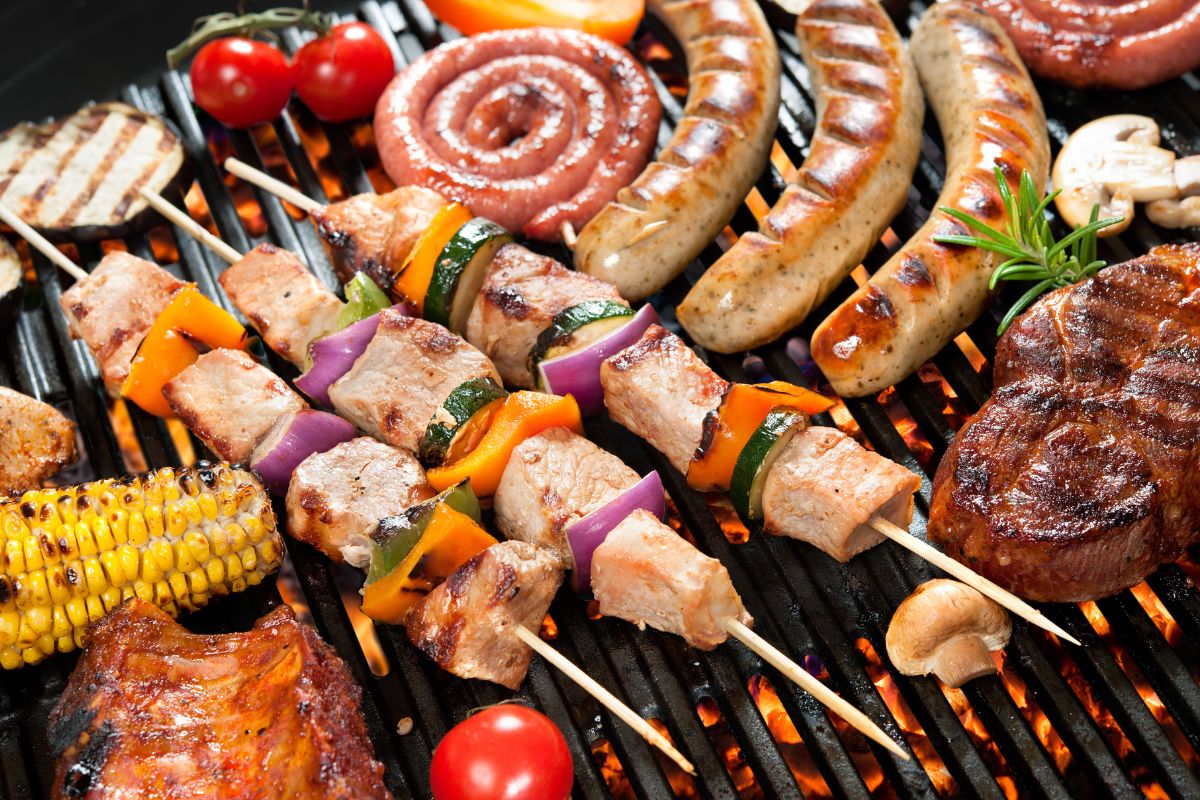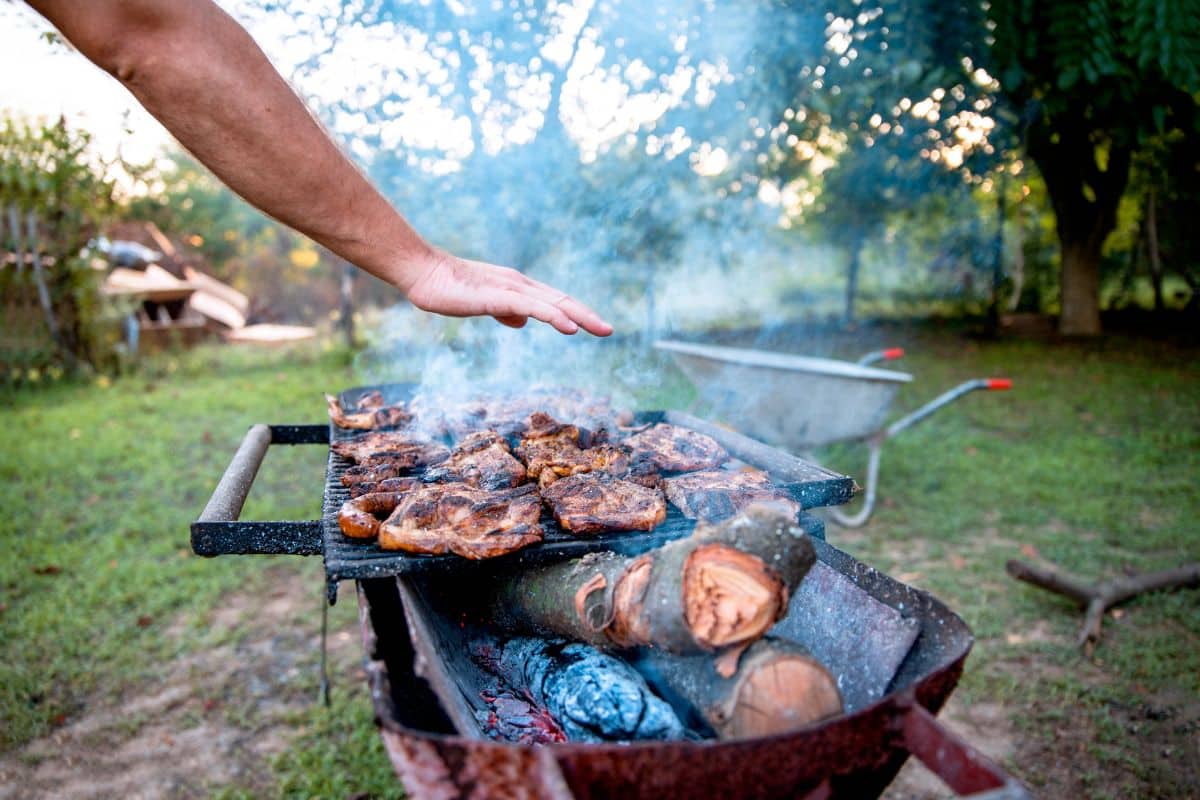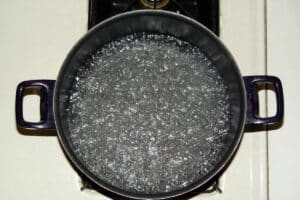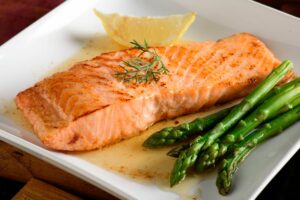If you want to grill hot dogs, steaks, and burgers that taste amazing, you’ll need to understand what medium heat on a grill means.

Essentially, medium heat on a grill isn’t one temperature measure, but it’s a range that starts at 300°F (150°C) and ends at 400°F (205°C).
This large range is appropriate for cooking several foods to give them a nice flavor, with a lower chance of burning.
You’ll find out more about medium heat on a grill in this post, including medium heat’s three settings, how to check a grill’s temperature, and how to change the heat coming from a grill.
What Does Medium Heat On A Grill Mean?
As mentioned above, medium heat on a grill ranges from 300°F to 400°F. Medium heat involves three different settings which are all best for different purposes.
The three temperature settings are all part of the medium range, but understanding how each one is different can affect the way your food tastes.
Medium Low
A grill’s medium range begins with medium-low. This is the lowest temperature that’s suitable for traditional grilled foods, though there are some exceptions, like smoked or slow-cooked meals.
The medium-low setting starts at 300°F and finishes at 325°F, though it primarily looms around 325°F.
This is suitable for food that needs to be roasted or baked. This may take longer, but the residual flavor makes the process worth it.
Medium-low heat is mainly used for things that explode under higher temperatures, like hot dogs, brats, and sausages. These may cook a little slower, but the excess time ensures your food takes on smokey flavors and juicy consistency.
The lower end, near 300°F, is nice for smoking particular meat, though some prefer to smoke on a lower heat setting.
Medium
The medium setting in the medium range is between 325°F and 375°F. This is enough to brown veggies and meat, but low enough to gradually cook the insides of certain food.
Grilling at a slightly higher temperature ensures that the insides cook rapidly, without leaving the product on the grill for a long time. This may turn the meat or food’s exterior dry and hard.
The medium heat setting is primarily used for thick cuts, like whole birds, steaks, and tougher types of fish. The heat chars the food’s surface well but leaves its inner flesh tender and soft.
Medium High
The medium-high temperature range lies between 375°F and 450°F.
Most high-temperature grilling is carried out at this setting, particularly things like fish fillets, cooking burgers, and some meat joints. It’s also suitable for some firm and tough vegetables, like potatoes and carrots.
A medium-high setting sears food rapidly, browning a food’s surface well. Despite this, the heat level is suitably low to cook through certain foods.
This level prepares food much quicker compared to the medium setting, which saves you 10-15 minutes when using open grills.
Why Does Temperature Matter When Grilling?
The right heat setting is very important when it comes to grilling.
If the heat is too low, it’s harder to cook the insides of your meat, and you’ll struggle to get a decent browning. If the heat is too strong, you’ll burn the outside of your food before the food’s insides start to cook.
Most types of meat prefer a slight sear on their outside with a gradual, slow cook on the inside. This is why it’s so important to manage your grill’s heat settings.
Remaining inside the medium heat temperature range is best. This is low enough to cook the insides of your food, but high enough to sear the surface without burning.
Checking Temperature On A Grill
A lot of grills have an integrated thermometer on their lid. This displays the grill’s temperature when its lid is shut.
Keep in mind that this reading displays the average air temperature within the grill. This isn’t a true depiction of how hot the grates are.
Several recipes may involve cooking on medium heat, but this is regarding the air temperature within the grill, not the grates.
A thermometer will also measure how hot the air temperature is, not the grates. Grill thermometers are usually found 12 inches above a grill’s grate.
This is why grates are hotter than the temperature depicted by a thermometer, as the grate is in contact with a flame. So, if your grill’s thermometer displays 360°F, the grates could be as hot as 500°F.
If your recipe involves a particular grate temperature, you can use a heat gun. Also known as an IR thermometer, a heat gun shines a laser at a surface to check how hot it is.
A heat gun will provide an exact reading of the grate’s temperature. This is ideal for checking how hot various surfaces are, like bread racks or pans.
You can also use a grill surface thermometer to check how hot your grates are. These work like a grill’s lid thermometer, except they are located directly on the grates.
These grill surface thermometers can turn dirty from grease and smoke, so you may prefer to use a heat gun instead.
Checking Medium Heat With No Thermometer
Managing how hot your grill is can be very difficult, even if you have tools, like a heat gun, to help.

If you don’t have a heat gun or thermometer on hand, or if your grill’s thermometer is faulty, how can you check the temperature on your grill?
You can use the hand test to assess how hot your grill is. To perform the test, you’ll need to see how long you can keep your hand a few inches away from the flames.
Carefully place a flat palm five inches above the flames and see how long you can keep the hand in the same position.
If you notice the heat straightaway and struggle to keep your hand over the fire, the grill will be too high, so you’ll need to decrease its temperature. If the heat is manageable, but for less than three seconds, the grill is still very high.
If you can keep your hand above the flames for five seconds, the grill will be at a medium-high temperature. If you’re preparing any delicate foods, like chicken, you should turn the grill down slightly.
If your hand can handle the grill’s heat for around seven seconds, the grill will be at a medium temperature setting. If you can keep your hand above the fire for 8-10 seconds, the grill will be at a medium-low setting.
Remember that even if your grill’s thermometer is off slightly, it can still be used to see if the grill is close to your desired range.
Changing Your Grill’s Heat Setting
The way you change a grill’s temperature and maintain a certain heat level will vary based on the kind of grill you have.
For the most part, it’s easier to manage a gas grill. These are like stove tops as you turn the burner’s knob to increase or decrease the flame.
If you close the grill’s lid, the temperature inside the grill will rise. If you open the grill’s lid, heat will escape the grill and fresh air will come into contact with the grates.
This will lower the grill’s internal temperature, though the grates will stay hot.
Managing a charcoal grill’s temperature is a lot harder. If you want to increase or decrease the heat, you’ll need to adjust how much charcoal you use.
You need to add more charcoal to increase the grill’s heat and use less when you want a cooler temperature. Spreading out and breaking up the charcoal will also lower the temperature within a grill.
Charcoal grills do give food a pleasant smokey taste and smell, but it’s easier to control temperature settings with a gas grill.
Charcoal requires oxygen to burn. You can change a grill’s temperature by modifying the amount of oxygen it receives.
Charcoal grills tend to have a minimum of two vents. One is located at the top of the grill and the other at the base.
Regulating these vents affects the airflow which then adjusts the amount of heat. Shutting the vents means the charcoal receives less oxygen as fuel, extinguishing the fire as a result.
Best Food For Medium Heat Grilling
Now that you know more about medium-heat grilling, here are some foods that you can cook at medium temperatures:
Steaks
Steaks are some of the best kinds of meat to prepare at medium heat. You can keep the meat juicy and savory in the center while giving the outside a crisp sear.
Hot Dogs And Burgers
You can use medium-heat grilling to bring out a burger’s juicy flavors.
Hot dogs are also ideal as they prefer lower heat temperatures. Higher heat settings can lead to the meat splitting or bursting open.
Chicken
Chicken tastes fantastic on the grill, especially if you take the time to season it beforehand.
Chicken usually prefers a medium-high heat between 350°F and 450°F, unless you’re smoking the meat. If you are smoking chicken, the meat prefers indirect cooking over much lower heat settings, around 225°F.
You can use an instant-read thermometer to check when your chicken is done. Its internal temperature needs to read 165°F before it’s suitable for consumption. Avoid cooking it over this temperature, as this can dry the meat out from the inside.
Kebabs And Vegetable Skewers
Meat kebabs love medium heat grilling. The heat is enough to cook the meat quickly while letting the juices infuse the item with flavor.
This is also the case with vegetable skewers. The heat can brown your vegetables well on the outside but keeps them crisp and juicy in the middle.
Bell peppers paired with steak or beef pieces work well, as the peppers add a satisfying crunch against the tender meat.
You can also add pineapple slices to your skewers, as their sweetness complements the savory notes from the meat and vegetables.
Final Thoughts
Now you know more about medium-heat grilling!
Medium heat grilling ranges between 300°F and 400°F. This consists of three heat settings: medium-low, medium, and medium-high. Understanding the differences between these settings ensures that your meat turns out well.
Most grills have an integrated thermometer that measures the grill’s air temperature. If you want to know how hot the grill’s grates are, you can purchase a heat gun to check.
It’s also advisable to invest in a high-quality thermometer. This makes it easier to grill meat, vegetables, and even fruit to your desired temperature.
We hope that you try experimenting with medium-heat grilling at home!







